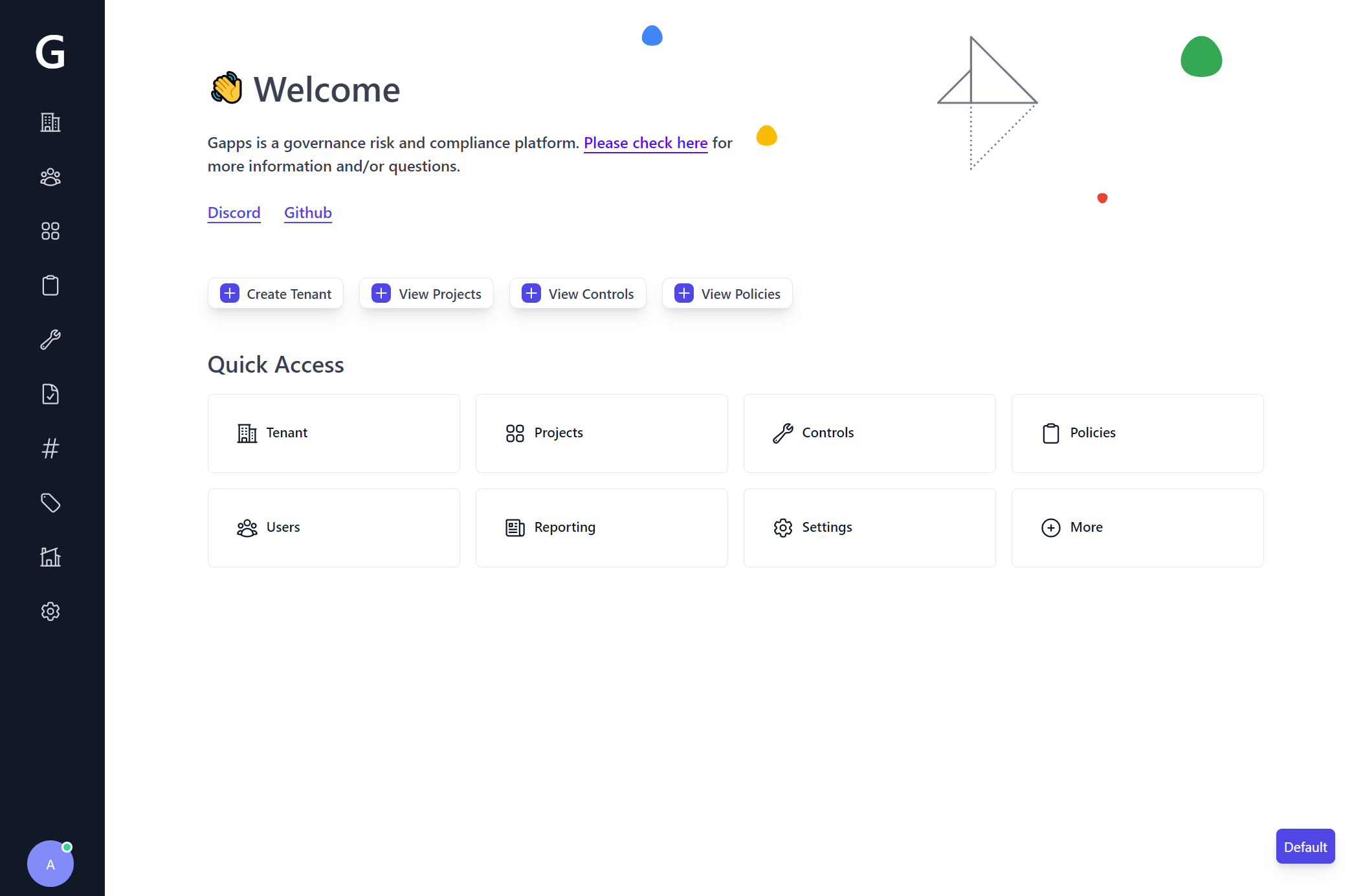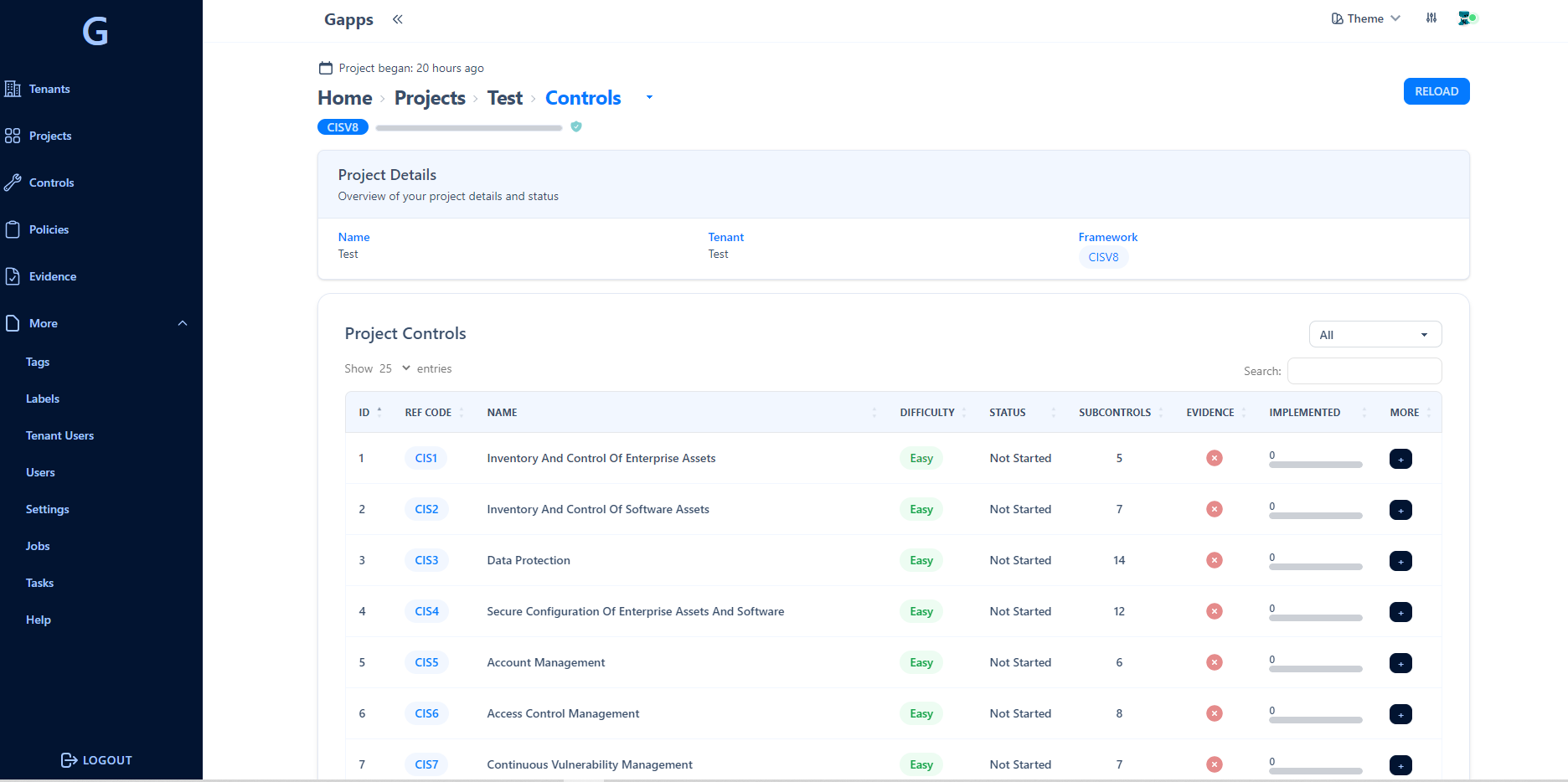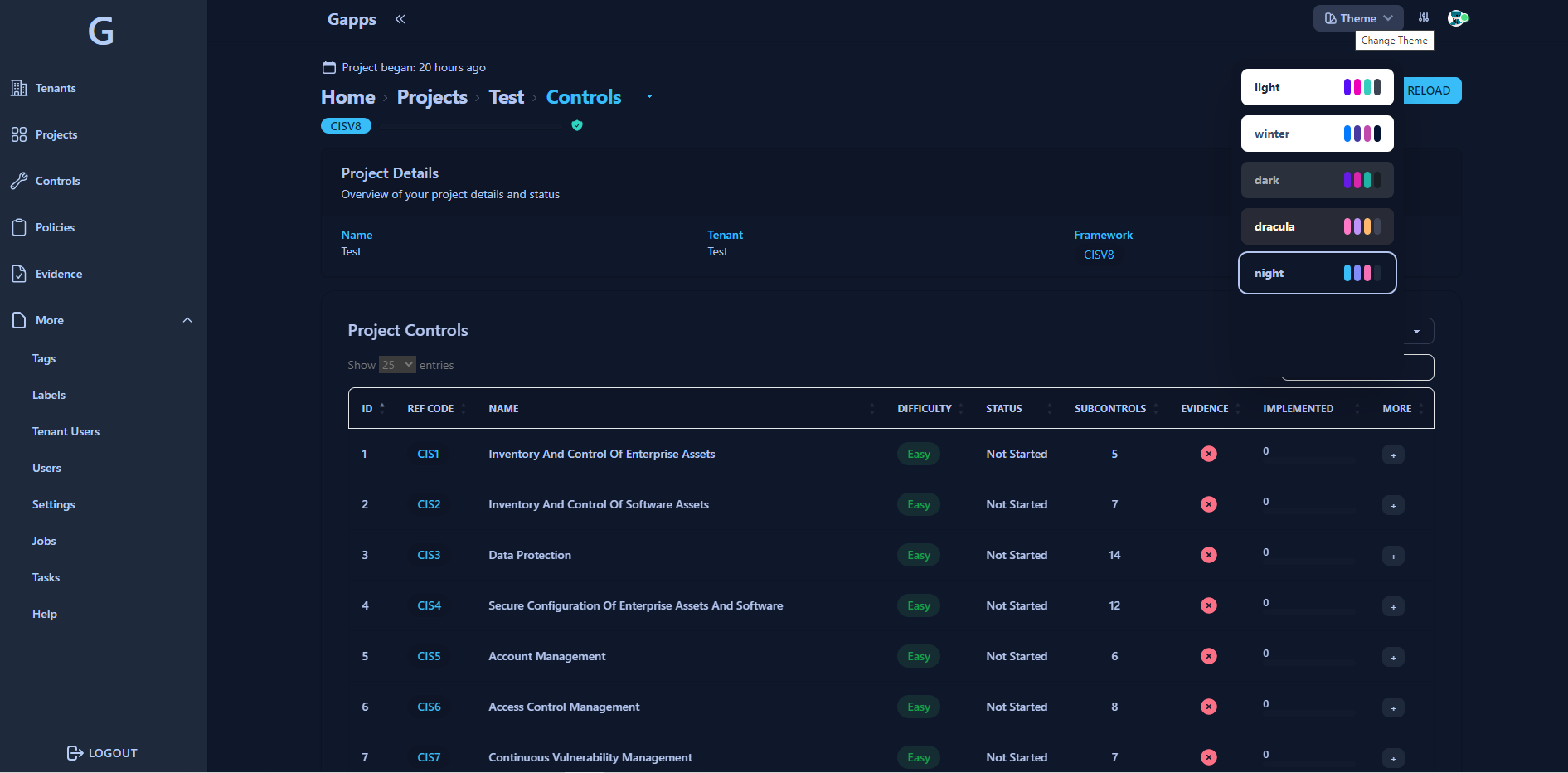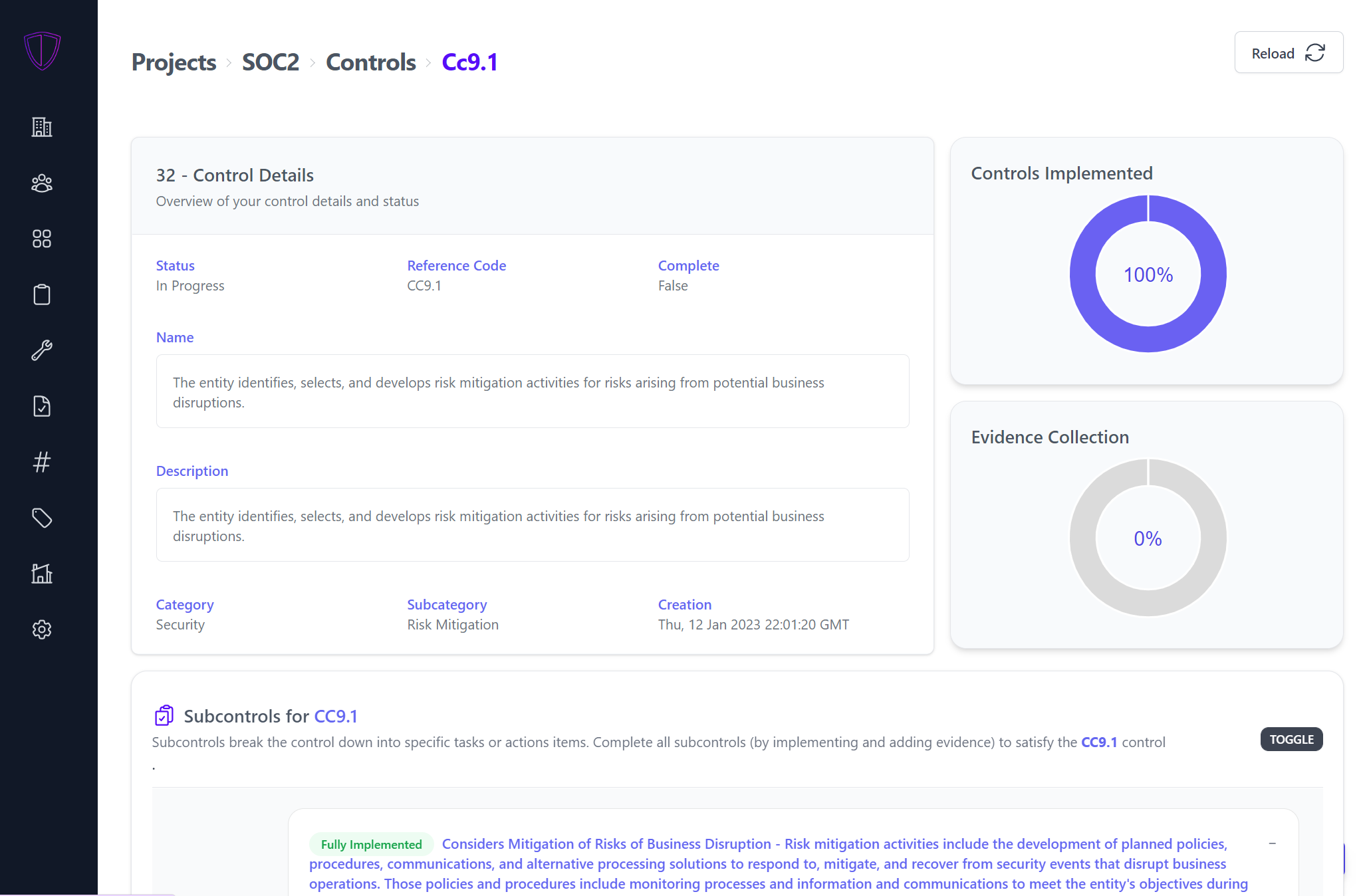❄️ View the Gapps site
- Interested in some form of partnership or new license? Contact me on discord
- Stay up to date on changes: https://forms.gle/EXigxbcWTSXcPnjw7
- Discord: https://discord.gg/9unhWAqadg
- SOC2, NIST CSF, NIST-800-53, CMMC, HIPAA, ASVS, ISO27001, CSC CIS18, PCI DSS and SSF have been added! That makes 10 total frameworks
- Total revamp of the UI
- Multi-tenancy is now supported!
- Collaboration with auditors
- Vendor Questionnaires
- Control automation?
- Endpoint agents for compliance?
- More frameworks?
- Take a look at the current roadmap or submit a issue
Gapps is an Security compliance platform that makes it easy to track your progress against various security frameworks. Gapps is currently in Alpha mode - while it works great, there may be some breaking changes as it evolves. Please do not use this in production.... yet!.
- Supports 10 security compliance frameworks (more coming)
- 1500+ controls and 25+ policies out of the box for the frameworks (majority of policies are sourced from strongdm/comply)
- Track the status of each control
- Add custom controls/policies
- WYSIWYG content editor
- Vendor questionnaires
Gapps-3.1.mp4
| Home Dashboard |
|---|
 |
| Project Controls |
|---|
 |
| Project Controls (Dark Mode) |
|---|
 |
| Track Progress of Controls |
|---|
 |
The following instructions are to get you started very quickly. The image will be pulled from Docker Hub
$ git clone https://github.com/bmarsh9/gapps.git; cd gapps
$ docker-compose up -d
The server should be running on http://<your-ip>:5000
The default email/password is admin@example.com:admin
Next, create a project and select the framework (SOC2). Based on the selected criteria, controls and policies will be automatically added to your project. You can also go to the Controls and Policies page and add them to your project.
You can setup email (for sending user invites) as well by setting the following environment variables (docker-compose file or elsewhere)
MAIL_USERNAME="email@gmail.com"
MAIL_PASSWORD="app password" # https://support.google.com/accounts/answer/185833?hl=en
- SOC2
- CMMC
- ASVS
- ISO27001
- HIPAA
- NIST CSF
- NIST 800-53
- CSC CIS 18
- PCI DSS
- SSF (custom framework "Startup Security Framework")
- Authentication is fully functioning but authorization is not complete. In other words, the roles assigned to users are not respected. There is a ticket open to address this
- The mitigation details of the controls are not documented. So it won't tell you how to mitigate a specific control. This requires a ton of work to complete but there is a ticket
- Difficulty to Implement (dtc) is a field attached to the controls and every single control is labeled as "Easy" (that doesn't actually mean it is easy). This also requires a ton of work to update.
If you get a database connection error trying to start Gapps, you need to update (or remove) your env variables
[INFO] Checking if we can connect to the database server: postgresql://db1:db1@localhost/db1
[ERROR] could not connect to server: Connection refused
Is the server running on host "localhost" (127.0.0.1) and accepting
TCP/IP connections on port 5432?
could not connect to server: Cannot assign requested address
Is the server running on host "localhost" (::1) and accepting
TCP/IP connections on port 5432?
Can usually be fixed by unsetting two variables if running within docker. If you want to use a external database, see the next FAQ
unset SQLALCHEMY_DATABASE_URI
unset POSTGRES_HOST
The value db1 is the default value for the username, database and password. If you would like to change it, update db1 with the respective values and postgres for the host.
export POSTGRES_HOST=${POSTGRES_HOST:-postgres}
export POSTGRES_PASSWORD=${POSTGRES_PASSWORD:-db1}
export POSTGRES_USER=${POSTGRES_USER:-db1}
export POSTGRES_DB=${POSTGRES_DB:-db1}
export SQLALCHEMY_DATABASE_URI="postgresql://db1:db1@postgres/db1"
When starting Gapps for the first time, it will automatically create the database models. If you want to reset the data (e.g. delete all data), you can set the RESET_DB env variable such as export RESET_DB=yes.
Sometimes you may want to run Gapps outside of Docker. You can do this by starting the Postgres container and then starting Gapps in the foreground.
- Uncomment ports declaration here
- Start the postgres container:
docker-compose up -d postgres - Set the following env variables:
export POSTGRES_HOST=${POSTGRES_HOST:-localhost}
export POSTGRES_PASSWORD=${POSTGRES_PASSWORD:-db1}
export POSTGRES_USER=${POSTGRES_USER:-db1}
export POSTGRES_DB=${POSTGRES_DB:-db1}
export SQLALCHEMY_DATABASE_URI="postgresql://db1:db1@localhost/db1"
- Run
export FLASK_CONFIG=development;bash run.sh - Gapps should be running and connected to the database. You can now make changes to the code.
- Download the docker-compose.yml file
- Open up a elevated command prompt and change directories (cd) to where the docker-compose.yml file was downloaded (likely Downloads)
- Run
docker compose up